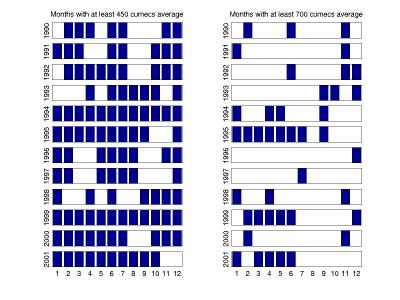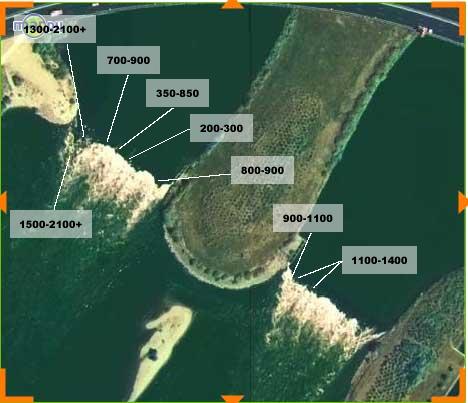
 |
|
LE NEWS |
GUIDE |
FORUM |
VIDEO |
CAMPING |
TRANSPORT |
CONTACT
|
|
In terms of pure technical difficulty the wave is equivalent to about river Grade IV but there are conditions where the boundary between catching a fun controlled ride or getting a nasty beating is rather thin. |
Hawaii-sur-Rhone can be dangerous. The Rhone is wide and fast-flowing. The whirlpools can be large, deep and violent at some levels. The holes are always powerful and paddles are ripped from hands on a regular basis. Spray-decks pop daily. Injuries happen. The holes can also be nasty. If you get trashed in a hole, hit your head and fall unconscious rescue could come too late. At some levels you could swim for several miles if there is no-one to rescue you. This is not a place for beginners. This is not a place for people who do not have confidence in their roll. Be sensible. If you are unsure then ask someone who is in the know. |
You want to aim for high flows but, as always, predicting and planning for these is the tricky part. The best levels occur when it is raining upstream (Ain, Jura, Franche Compte, Switzerland) and also, during the skiing season, when any rise in temperatures will trigger snowmelt. Flows can be good throughout the year but highest levels occur from November through to June. You want to avoid August, September and to a lesser extent October. TheRhone is dam-regulated so the water level fluctuates throughout the day to match the demand for electricity. Demand is low at weekends and during the early hours of the morning. Monday evenings generally boast the best weekly flows. Do bear in mind that at weekends the level can drop by up to 400 cumecs. That is bad! That is really all you need to know. Skip to the next section. If you are in pursuit of deeper understanding, however, then read on.  Left: Months with flows above 450 m3/s (good levels). Right: Months with flows above 700 m3/s cumecs (fantastic levels). The two charts above summarise monthly flows over a 10 year period (1990 to 2001). The months of the year are represented numerically (1-12). A blue square indicates that the average monthly flowrate is above the chart threshold (450 or 700 m3/s). The left chart shows that nice levels (above 450) are very common. For example, during 1994 and 1999 these levels persisted throughout the whole year. In general though, Hawaii tends to work for about 10 months of the year. The months least likely to boast good levels are August, September and to a lesser extent October. The right chart shows that the fantastic levels (above 700) occur more randomly but are not limited to any one particular month. The season where they are most likely is November through to June. Predicting the level at Hawaii is like predicting the weather. In fact it can be worse as sometimes we don't undertand where the water is coming from. For example, summer 2003, whilst France suffered an intensive heat-wave and subsequent drought there was often a very decent 500+ cumecs here... |
Since winter brings good water levels one might wonder what it is like paddling here at that time? Despite being the South of France it can get nippy. The Rhone never freezes over, however. The good news is that when the levels are up, so are the temperatures. It also depends what you are used to. Coming from Northern Europe, I find it warm here. |
Hawaii-sur-Rhone is formed from a weir that spans two forks of the Rhone.
The Rhone has taken it's toll on the structure in terms of erosion so the
weir is non-uniform. In addition, there are canoe passes, fish ladders and
part of the weir was blown up by dynamite to remove a dangerous hole. The
end result is that there is not one wave but a large variety of waves and
each one works at a different level.
The wave is reliable. With the current configuration, most water levels provide fantastic features but there are a couple of levels that are crap. Coming from UK playspots, I seem to be far more tolerant of these than the locals! Most importantly, regardless of the level there is always somewhere to paddle. One of the concrete pillars broke in November 2003 and that affected the wave configuration significantly. Here is the current situation.  Hawaii-sur-Rhone as seen from above (scale: the blob top right is a lorry) 200 - 300 m3/s, The Broken Pillar Wave
A very fast, small, green wave. Not worth travelling for. If you just
happen to turn up at this level, then it can still be good fun. It's
catching this one that is the tricky bit.
There are three ways of catching this wave. To the uninitiated it is not obvious that there is an eddy of sorts behind the broken pillar that can be used. At some levels that is too fast so you have to drop in. When the pile is less retentive the sneaky third method comes into play. Drop down the ramp into the hole on surfer's left and then surf across. 350 m3/s, The Pillar Hole
This is the worst possible level. The wave is now a hole. The previous diagonal is gone, the pile is
very strong and if you passively wait for a gift to fall out of the sky
you'll never get anything done. You have to fight hard to create an
opportunity and then react quickly when it presents itself. Hard work that
gives little return. The one redeaming aspect is that it is good for entry
move practice.
450 - 800 m3/s, The Pillar Wave
The pillar wave is now fantastic. These are some of my favourite levels as
it is just the right mix of big, fun and not too intimidating. The surfing
is smooth and controlled and every move can be thrown. At best we get a 7ft
steep green wave and a baseball glove of a pile that is perfect for softly
catching errant boaters. 550 is probably the creme de la creme and at
around 700 there are opportunities to play all over the place.
700 - 900 m3/s, The Wall and the mini-Wall,
The Wall and the mini-Wall are both huge steep green waves.
The Wall can reach 10 ft in height. You feel very small when you're in there. It is intimidating. It is so fast, so steep and so bouncy that it is difficult to maintain control. Generally you have three seconds to do something for the camera before you wipe-out. Behind The Wall there is an enormous hole which will happily massage you for 15 seconds. Not to mention the powerful whirlpool along the eddyline ... The mini-Wall is just as tall but narrower and open to one side. It can be hard to master but, in contrast to it's frantic big brother, can also sometimes be a soulful surf. No nastiness awaits when you wipe out from the mini-Wall. 1000 - 1200 m3/s, The Quarter Pipe
This is unique. If you imagine a quarter pipe it is just about the right
size and has a vert section about the right size too. Only here have I ever
seen a perfectly vertical non-breaking standing wave. Even the Wall never
really goes completely vertical. The wave is a green strip about 4ft wide
with two big powerful piles either side and cannot be seen from the bank.
Despite it being green it is hard to get to the top of the wave and
consequently rather hard to wash off! In a sense it is very forgiving of
badly thrown moves.
900 - 1400 m3/s, The Left Fork
Above 900 the fantastic wave on the left fork of the Rhone comes into play.
It is huge. It is smooth and friendly. It is fast. It is steep. And there
is no nastiness awaiting when you wash off. As if that wasn't enough, there
is always good eddy service. This is the ultimate wave in playboating.
The higher the level the better. At 900 it is borderline and usually a green wave. Then as the levels rise the pile grows. 1300 cumecs is the ideal level. It closes at around 1400. 1000 - 1500 m3/s, The Miribel Wave
The Miribel wave is 3 miles upstream. At 1000 it provides a soft pile for
cartwheels. 1200 is probably the best level as it provides lots of choice.
At 1600 it is a river wide hole with possiblities for play at either end.
Take a longer boats. The water is slow and soft so modern short boats are
less fun.
1300 - 2100 m3/s The Launching Ramp, The Bowl
At 1300 the Ramp is a bit feisty and the the Bowl has not yet formed behind
it. As the level rises the ramp loses it's nasty edge and the Bowl comes
into play. The ideal level for both features is about 1600. The Bowl can
always be caught from the eddy. In longer boats (e.g. slalom boats, Pyranha
Inazones, Wavesport X, Riot Trickster) you can even catch the Ramp from the
eddy.
Above 2100 cumecs things start to wash out but there are still waves here and there. Having never seen the Rhone at those levels, I will refrain from comment. Every day brings a different level and every level brings something new. It's great. On the other hand, just as one figures out how to get to the sweet spot at one level the wave changes and the job starts all over again ... |
This graph gives an idea of current levels.  |
There are a few local creeks that work when there is rain. Then, of course,
there are the French and Italian Alps which are just 2 hours drive away. The
best French creeking is in the Ardeche and the Cevennes and it takes about 3
hours to get there. The Massif Central and the Jura are the other popular
destinations within a couple of hours of Lyon.
For guides to rivers in France have a look at eauxvives.org. which is a hugely popular french language whitewater website. |
The wave is in a park. You can leave your car just a short distance upstream
but paddlers sometimes break through the perimeter fence to save themselves
those 100 yards. This leaves unsightly tyres marks in the grass fields and,
to add insult to injury, some paddlers feel the park is a good venue to
show off their rally skills. Afterwards, the local pikeys use the opening
created by paddlers to leave their broken bottles, tins and needles at the
wave. There has even been cases of physical aggression against paddlers.
Charming.
There is a gate for use by the emergency services. Paddlers have tried various innapropriate tools to force it open. The problem is that this has gradually damaged the mechanism and the emergency services now have trouble opening their own gate. They know which group is to blame. Walkers regularly ask us if playing at the wave is legal. So far it is, but the local council could easily pass a bylaw prohibiting our activity. That would be the end of Hawaii-sur-Rhone. Please respect the area. |
|